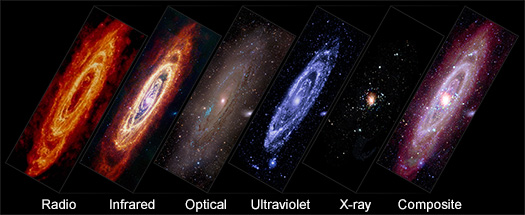A Tour the Andromeda Galaxy - More Videos
The galaxy M31 has played an important role in many aspects of astrophysics, but particularly in the discovery of dark matter. In the 1960s, astronomer Vera Rubin and her colleagues studied M31 and determined that there was some unseen matter in the galaxy that was affecting how the galaxy and its spiral arms rotated. This unknown material was named “dark matter.” Its nature remains one of the biggest open questions in astrophysics today, one which NASA’s upcoming Nancy Grace Roman Space Telescope is designed to help answer.
This new composite image contains data of M31 taken by some of the world’s most powerful telescopes in different kinds of light. This image includes X-rays from NASA’s Chandra X-ray Observatory and ESA’s (European Space Agency’s) XMM-Newton (represented in red, green, and blue); ultraviolet data from NASA’s retired GALEX (blue); optical data from astrophotographers using ground based telescopes (Jakob Sahner and Tarun Kottary); infrared data from NASA’s retired Spitzer Space Telescope, the Infrared Astronomy Satellite, COBE, Planck, and Herschel (red, orange, and purple); and radio data from the Westerbork Synthesis Radio Telescope (red-orange).
Each type of light reveals new information about this close galactic relative to the Milky Way. For example, Chandra’s X-rays reveal the high-energy radiation around the supermassive black hole at the center of M31 as well as many other smaller compact and dense objects strewn across the galaxy. A recent paper about Chandra observations of M31 discusses the amount of X-rays produced by the supermassive black hole in the center of the galaxy over the last 15 years. One flare was observed in 2013, which appears to represent an amplification of the typical X-rays seen from the black hole.
These multi-wavelength datasets are also being released as a
sonification, which includes the same wavelengths of data in the new
composite. In the sonification, the layer from each telescope has been
separated out and rotated so that they stack on top of each other
horizontally, beginning with X-rays at the top and then moving through
ultraviolet, optical, infrared, and radio at the bottom. As the scan
moves from left to right in the sonification, each type of light is
mapped to a different range of notes, from lower-energy radio waves up
through the high energy of X-rays. Meanwhile, the brightness of each
source controls volume, and the vertical location dictates the pitch.
Credit: NASA/CXC/SAO/K.Arcand, SYSTEM Sounds (M. Russo, A. Santaguida)
NASA's Marshall Space Flight Center in Huntsville, Alabama, manages the Chandra program. The Smithsonian Astrophysical Observatory's Chandra X-ray Center controls science operations from Cambridge, Massachusetts, and flight operations from Burlington, Massachusetts.
Visual Description:
Like all spiral galaxies viewed at this distance and angle, Andromeda appears relatively flat. Its spiraling arms circle around a bright core, creating a disk shape, like a large dinner plate. In most of the images in this collection, Andromeda's flat surface is tilted to face our upper left.
This collection features data from some of the world's most powerful telescopes, each capturing light in a different spectrum. In each single-spectrum image, Andromeda has a similar shape and orientation, but the colors and details are dramatically different.
In radio waves, the spiraling arms appear red and orange, like a burning, loosely coiled rope. The center appears black, with no core discernible. In infrare,d light, the outer arms are similarly fiery. Here, a white spiraling ring encircles a blue center with a small golden core. The optical image is hazy and grey, with spiraling arms like faded smoke rings. Here, the blackness of space is dotted with specks of light, and a small bright dot glows at the core of the galaxy. In ultraviolet light the spiraling arms are icy blue and white, with a hazy white ball at the core. No spiral arms are present in the X-ray image, making the bright golden core and nearby stars clear and easy to study.
In this release, the single-spectrum images are presented side by side for easy comparison. They are also combined into a composite image. In the composite, Andromeda's spiraling arms are the color of red wine near the outer edges, and lavender near the center. The core is large and bright, surrounded by a cluster of bright blue and green specks. Other small flecks in a variety of colors dot the galaxy, and the blackness of space surrounding it.
This release also features a thirty second video, which sonifies the collected data. In the video, the single-spectrum images are stacked vertically, one atop the other. As the video plays, an activation line sweeps across the stacked images from left to right. Musical notes ring out when the line encounters light. The lower the wavelength energy, the lower the pitches of the notes. The brighter the source, the louder the volume.
Fast Facts for M31
Scale: Image; is about 192 arcmin (150,000 light-years) across.
Category: Normal Galaxies & Starburst Galaxies
Coordinates (J2000): RA 0h 42m 44s | Dec +41° 16´ 09"
Constellation: Andromeda
Observation Dates: 152 pointings between 1999 and 2012
Observation Time: 55 hours 30 minutes (2 days 7 hours 30 minutes)
Instrument: ACIS/HRC
Also Known As: Andromeda
Color Code: X-ray: red, green, and blue; UV: red, green, and purple; Optical: red, green, and teal; Infrared: red, orange, and purple; Radio: red and orange
Distance Estimate: About 2.5 million light-years


















